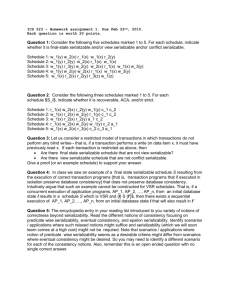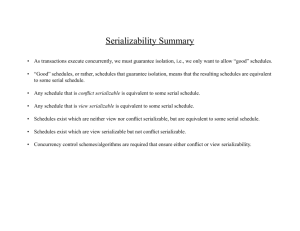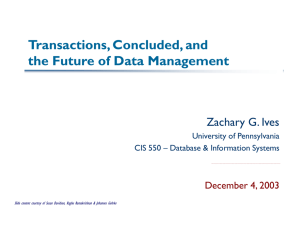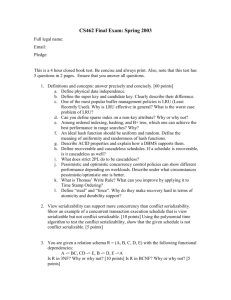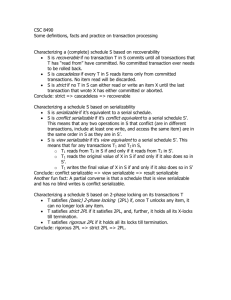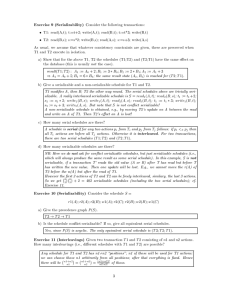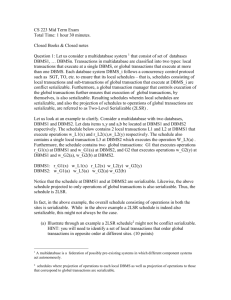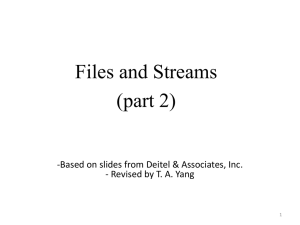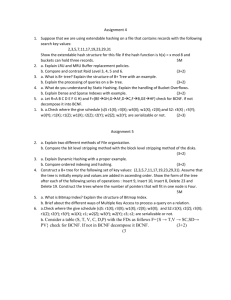View Serializability
advertisement
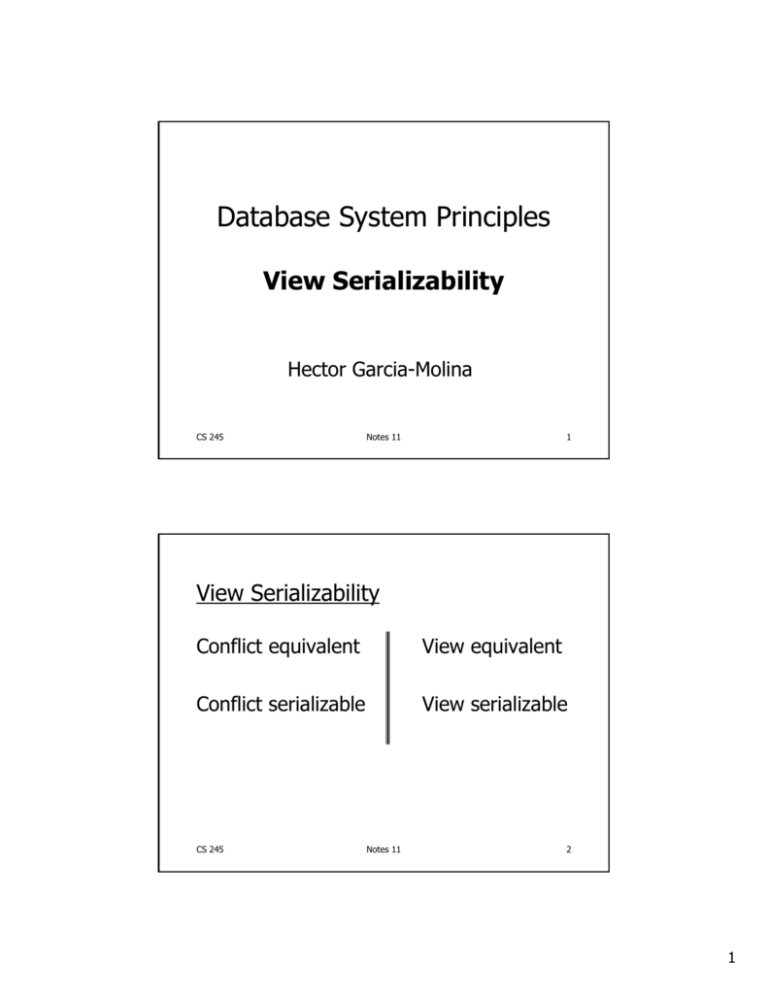
Database System Principles View Serializability Hector Garcia-Molina CS 245 Notes 11 1 View Serializability Conflict equivalent View equivalent Conflict serializable View serializable CS 245 Notes 11 2 1 Motivating example Schedule Q T1 Read(A) T2 T3 Write(A) Write(A) Write(A) CS 245 Notes 11 3 Same as Q = r1(A) w2(A) w1(A) w3(A) T2 P(Q): T1 T3 ➽ Not CS 245 conflict serializable! Notes 11 4 2 But now compare Q to Ss, a serial schedule: Q T1 Read(A) Write(A) Ss CS 245 T1 Read(A) Write(A) T2 T3 Write(A) Write(A) T2 Write(A) T3 Write(A) Notes 11 5 • T1 reads same thing in Q, Ss • T2, T3 read samething (nothing?) • After Q or Ss, DB is left in same state ➨ So what is wrong with Q? CS 245 Notes 11 6 3 Definition Schedules S1,S2 are View Equivalent if: ⇒ means “reads (1) If in S1: wj(A) ⇒ ri(A) value produced” then in S2: wj(A) ⇒ ri(A) (2) If in S1: ri(A) reads initial DB value, then in S2: ri(A) also reads initial DB value (3) If in S1: Ti does last write on A, then in S2: Ti also does last write on A CS 245 Notes 11 7 Definition Schedule S1 is View Serializable if it is view equivalent to some serial schedule CS 245 Notes 11 8 4 View Serializable ? Conflict Serializable • View Serializable ⇒ Conflict Serializable e.g., See Schedule Q ? • Conflict Serializable ⇒ View Serializable CS 245 Notes 11 9 Lemma Conflict Serializable ⇒ View Serializable Proof: Swapping non-conflicting actions does not change what transactions read nor final DB state CS 245 Notes 11 10 5 Venn Diagram All schedules View Serializable Conflict Serializable CS 245 Notes 11 11 Note: All view serializable schedules that are not conflict serializable, involve useless write S= W2(A) … W3(A)….. no reads CS 245 Notes 11 12 6 How do we test for view-serializability? ➳ P(S) not good enough… (see schedule Q) CS 245 Notes 11 13 • One problem: some swaps involving conflicting actions are OK… e.g.: S = ….w2(A)……r1(A).... w3(A)… w4(A) this action can move if this write exists CS 245 Notes 11 14 7 • Another problem: useless writes S = …..W2(A)…….. W1(A)….. no A reads CS 245 Notes 11 15 To check if S is View Serializable (1) Add final transaction Tf that reads all DB (eliminates condition 3 of V-S definition) ? E.g.: S = …..W1(A)…….. W2(A)… rf(A) Last A write CS 245 Notes 11 add 16 8 (2) Add initial transaction Tb that writes all DB (eliminates condition 2 of V-S definition) ? E.g.: S = wb(A) ... r1(A) … w2(A) … add CS 245 Notes 11 17 (3) Create labeled precedence graph of S: 0 Tj (3a) If wi(A) ⇒ rj(A) in S, add Ti → CS 245 Notes 11 18 9 (3b) For each wi(A) ⇒ rj(A) do consider each wk(A): [Tk ≠Tb] - If Ti ≠Tb ∧ Tj ≠Tf then insert p Tk → Ti some new p p Tj → Tk - If Ti =Tb ∧ Tj ≠Tf then insert 0 Tj → Tk - If Ti ≠Tb ∧ Tj =Tf then insert 0 Ti Tk → CS 245 Notes 11 19 (4) Check if LP(S) is “acyclic” (if so, S is V-S) - For each pair of “p” arcs (p ≠ 0), choose one CS 245 Notes 11 20 10 Example: check if Q is V-S: Q = r1(A) w2(A) w1(A) w3(A) Q’ = wb(A) ⇒r1(A) w2(A) w1(A) w3(A) ⇒rf(A) T1 0 Tb rule 3(a) rule 3(b) 0 T2 0 0 Tf 0 0 LP(S) acyclic!! S is V-S T3 CS 245 rule 3(b) Notes 11 21 Another example: Z=wb(A) ⇒r1(A) w2(A) ⇒r3(A) w1(A) w3(A)⇒rf(A) T1 0 Tb 1 do not pick this one of “1” pair CS 245 1 0 T2 0 T3 0 0 0 Tf 0 LP(Z) acyclic, so Z is V-S (equivalent to Tb T1 T2 T3 Tf) Notes 11 22 11 Ss=wb(A)r1(A)w1(A)w2(A)r3(A)w3(A)rf(A) T1 T2 T3 Z + Ss indeed do same thing CS 245 Notes 11 23 • Checking view serializability is expensive • Still, V-S useful in some cases... CS 245 Notes 11 24 12 Example on useless transactions: S = w1(A) r2(A) w2(B) r1(B) w3(A) w3(B) CS 245 Notes 11 25 S’ = Tb w1(A)⇒r2(A)w2(B)⇒r1(B) w3(A)w3(B) ⇒ Tf T1 Tb 0 0 T2 CS 245 Notes 11 T3 0 Tf 26 13 • If we only care about final state ➽ remove T1, T2; i.e., remove useless transactions • If we care what T1, T2 read (view equivalence), then do not remove useless transactions CS 245 Notes 11 27 • If all transactions read what they write, (I.e., Tj=... Rj(A) … Wj (A)…) then view serializability = conf. serializability [Another way of saying: blind writes appear in any view-serializable schedule that is not conflict serializable] CS 245 Notes 11 28 14 Proof(?): say S1 is view-ser. and no blind writes. S1 V-equiv to Ss, serial schedule. (1) Goal: Show that T1 → T2 in P(S1) ⇒ T1 <ssT2 (2) Assume T1 → T2 if S1 = …w1(A) … r2(A)… (direct read) clearly T1 <ssT2 if S1 = …w1(A)… r3(A) w3(A) ... r2(A)… also T1 <ssT2 if S1 =...rr1(A) r3(A) … w1(A) … w3(A) … r2(A) not possible: T1,T3 not serializable Other cases similar... CS 245 Notes 11 29 Implications: If no blind writes, view-ser ⇐⇒ conf-ser P(S) acyclic ⇒ all transactions read the same as in a serial schedule CS 245 Notes 11 30 15
